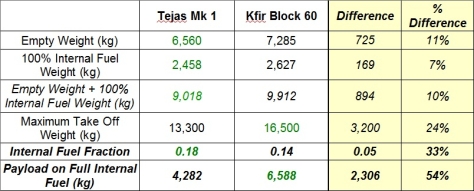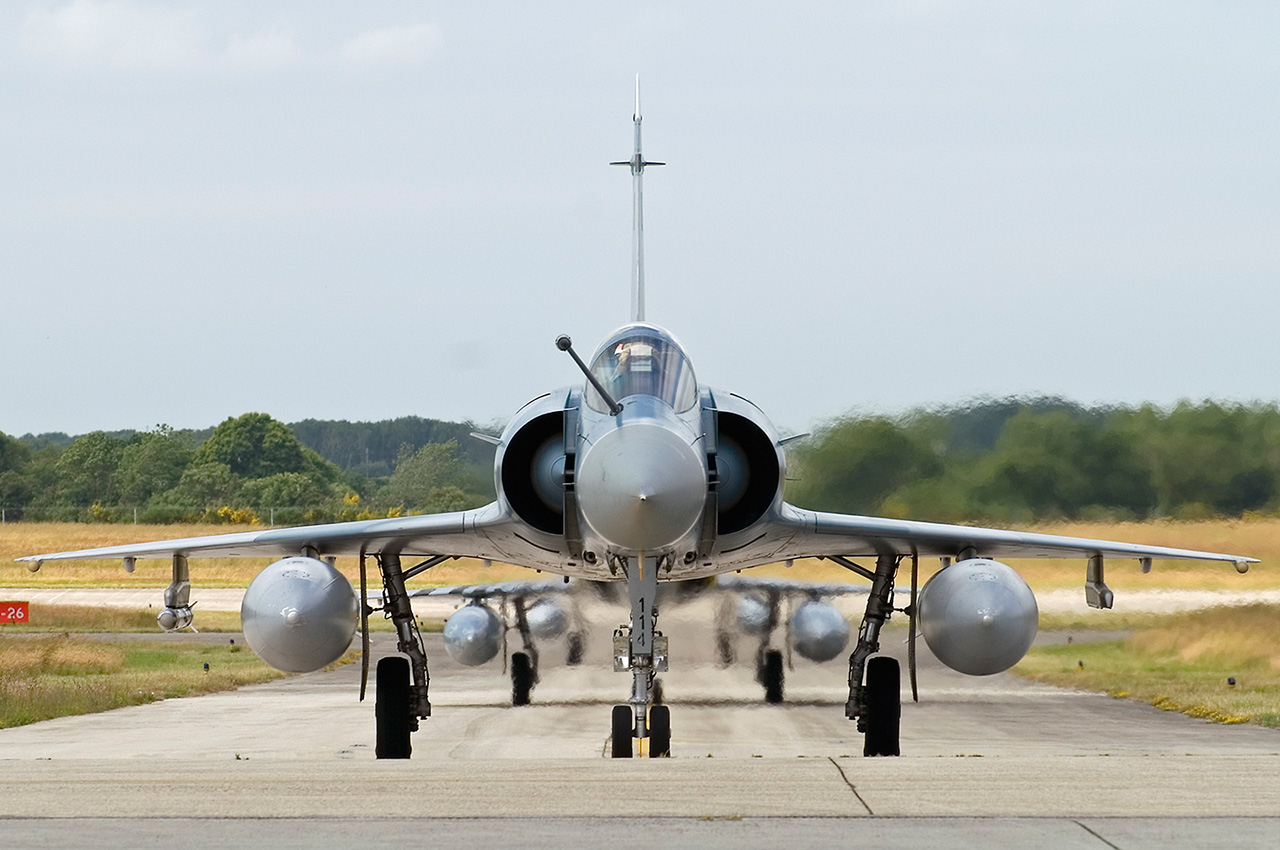The Indian manufacturer of the Tejas aircraft recently announced that it is pegging the price of that aircraft at USD 26 million
[1], which puts it near the price range of the Kfir Block 60 which is selling at USD 20 million. The relatively low price of the Tejas means it is more affordable for our budget-conscious Air Force and thus worthy of consideration, hence I am starting this informal evaluation of the Tejas by comparing it to the Kfir Block 60
‘Aircraft Background’
The Kfir is based on the Mirage III/5 delta-winged aircraft whose blueprints were stolen by the Mossad (as is now detailed in various spy books and articles
[2]), and is described as an all-weather, Multi-Role Fighter aircraft. It was made by the Israel Aircraft Industry (IAI) and first entered service in 1975, seeing extensive combat duty with the Israeli Air Force (IAF) before finally being retired by the IAF in 1996.
A total of 220 Kfirs were built, and currently the air forces of Colombia, Equador and Sri Lanka are still operating the aircraft. All Kfirs being sold now are taken from the mothballed stocks of the IAF, but are refurbished and upgraded with advanced avionics plus a 40-year manufacturer’s guarantee. The latest version in the market is the “Block 60″ equipped with an Active Electronically Scanned Array (AESA) radar, the EL/M-2052.
[3]
The Tejas was developed indigenously by the Indian company, “Hindustan Aeronautics Limited” (HAL) and is described as a light, multri-role combat aircraft. It is intended to replace the MIG-21 Bison in the Indian Air Force (IAF) inventory, and had a very long development history, first being conceived in the early 1980s with the first prototype flying only in 2001. Despite that first flight over a decade ago, the aircraft is only scheduled to start entering service in 2015 with the IAF who ordered 40 aircraft. No export orders have yet been received for the Tejas, and only the Indian Navy is projected to be its next customer with an initial order of 6 aircraft. The current version is the “Mk1”, with an improved “Mk2” version in development with a longer fuselage, larger wing, a more powerful engine and higher payload.
[4]
‘Evaluation Notes’
For the “Maneuverability” and “Payload and Range” sections, the following considerations were made:
– Weights with 100% internal fuel was used to try to simulate the aircraft going into combat with full internal fuel after dropping their External Fuel Tanks.
– The weights of the armaments were not included as the RATIOS and DIFFERENCES BETWEEN BOTH AIRCRAFT will remain the same if they will be armed with the same type and same number of armaments.
– Fuel density of 0.81 kg/l was used to convert fuel capacity to kilograms
– Data for each aircraft was derived from various websites at
[5][6][7].
‘Manueverability’
For both aircraft’s maneuvering capability, I am looking at their LIMIT LOAD FACTOR*, WING LOADING* and POWER TO WEIGHT RATIO.* I would’ve wanted to take a look at more aspects like Stall Speed, Maximum Alpha, etc., but those data are hard to come by for both aircraft. Hence, these should suffice for now. Remember that a lower Wing Loading means the aircraft can turn tighter and vice-versa, and a higher Thrust-to-Weight Ratio means the aircraft can go faster going straight up or straight down and vice-versa.
* SUMMARY
– POSITIVE LIMIT LOAD FACTOR: Favors the Tejas slightly by 7% as it is rated up to 8G while the Kfir is only limited to 7.5G
– WING LOADING: Favors the Tejas with 10% lower wing loading compared to the Kfir
– THRUST TO WEIGHT RATIO: Consirable 17% advantage for the Tejas in terms of TTWR
+++ The Kfir already has a lower wing loading than most aircraft I compared so far, but the Tejas can turn even tighter due to having the same wing area, but having a lighter weight, thus driving that wing loading value lower even more.
+++ In terms of TTWR, the Tejas not only is lighter, it has a slightly more powerful engine, hence providing a TTWR of more than 1 even with a full internal fuel load. Overall, the Tejas is the more maneuverable aircraft.
‘Payload and Range’
For Range, I am using INTERNAL FUEL FRACTION (INTFF)* as a rough indicator how far each aircraft can go based on the internal fuel available to them.
The Kfir’s IntFF value was multiplied by 0.87 to reflect the estimated 13% more fuel consumption of its J79 Turbojet engines as compared to its later, more efficient version, the F404 Turbofan engine. For more explanation of this, refer to a special section at the bottom page**
* SUMMARY
INTFF: Favors the Tejas by a third (33%), indicating it can travel 33% farther for the same engine fuel efficiency.
– PAYLOAD: Favors the Kfir this time as it can carry a commanding 54% (2,306 kg) more load than the Tejas.
+++ The Tejas can travel further, but the Kfir can carry more load, so this would be somewhat even in my book. The Tejas’ 4,282 kg payload capacity is no slouch, though.

An IAI Kfir.
‘Air Combat-related Avionics and Weapons’
Here I am comparing the capability of both aircrafts in terms of Within Visual Range (WVR) and Beyond Visual Range (BVR) air combat thru their Avionics and Weapons available to them. Just some notes, though:
– RCS data are for “clean” aircraft, with no armaments or fuel tanks
– No solid references for the RCS and detection ranges for the Kfir B60. RCS is taken from an obscure internet reference, while detection range is just estimated to be 25% higher than the detection range of the EL/M-2032 radar
– Tracking range is assumed to be 85% of the Detection Range
– Closing velocity of 3,000 kph (equally divided to each aircraft) used to compute for First Look, First Shot advantage
– Missile impact is based on the top speed of its main BVR missiles
– Other data were taken from these websites:
[8][9]

* SUMMARY
– WVR COMBAT: Advantage for the Tejas because of its Fly By Wire (FBW) system
– BVR COMBAT: Practically EVEN for both aircraft because while the Tejas has less capable radar, it has a much lower Radar Cross Section (RCS) than the Kfir, and actually giving the Tejas a theoretical 2-second advantage in terms of Firs Look, First Shot capability.
+++ The Tejas’ low RCS is impressive at an estimated one-third that of a Mirage 2000
[9], thanks to the extensive use of composites and computer modelling for the shaping of the aircraft’s external structures. This is probably why HAL declared recently that the third version of the Tejas, the Mk3, will be a stealth version.
‘International Relations’
The Tejas clearly is the better aircraft overall based on the above evaluation, but there are other considerations as well not covered above. For one, relations between the Philippines have been lukewarm, at best. There aren’t many Indian tourists or businesses in the Philippines, and vice versa, not many Filipino tourists or businesses go to India. With Israel we at least have the United States as our major ally in common with them, but US-India relations have not really been that great either, especially recently with diplomatic row between them involving an Indian diplomat in the US.
[10]
If anything, India is closer to Russia (which in turn is close to China) than the US, with them getting their newest aircraft carrier, the INS Vikramaditya from Russia
[11] and co-manufacturing the now famous Brahmos Missile also with Russia.
[12] These are not showstoppers, of course, but something to be noted of, and more serious issues are present regarding the Tejas.
‘Availability and Service Record’
The more serious issues are AVAILABILITY and SERVICE RECORD. HAL is scheduled to ramp up production of the Tejas soon, but will it be able to meet its schedule? Would it be able to meet additional orders from the Philippines? And what happens if problems and/or accidents occur during introduction of the aircraft into service, how fast will HAL be able to adjust to these? Their 30 year development period of the Tejas does not necessarily inspire confidence that they will be able to adjust quickly and meet their original schedule.
In terms of service record, how reliable will the Tejas be once it goes into military service? How will its accident rate be like, will it be just average, or higher than normal? Remember that the Tejas is not officially based on any fighter design, it is a brand new aircraft design reportedly loosely or unofficially based on the Mirage.
The Kfir is also only “unofficially” based on the Mirage, but at least it already has a track record in military service, a generally fair one, and is still in service in a couple of air forces around the world right now. IAI also commits to be able to deliver the first Kfir within a year upon receiving an order.
[13]
‘Parting Shot’
The Tejas Mk1 can climb or dive faster, turn tighter, has a much longer range and much lower radar cross section than the Kfir. The Kfir’s only advantages are its payload capacity and its AESA radar. HAL took their time developing this aircraft, but you have to give them credit for coming up with a pretty good performer. However, the Tejas Mk1 is mainly unproven without a solid service record behind it, and there are doubts about its availability. For the Philippines right now, the Tejas would be like a “High Risk-High Reward” gamble, whereas the Kfir would be “Low Risk-Low Reward” option.
Personally … I would go with the Kfir, at least for now. The scenario for the Tejas would look something like this:
– Tejas scheduled to enter service in 2015
– Allow at least 3 years of military service up to 2018 to establish a service record
– Order Tejas in 2019, delivery by 2021
And all this assuming everything goes well with the Tejas, like no production delays, major design flaws or accidents causing major redesigns to occur. On the other hand, if we get our act together and order this year, we could have the Kfir by 2015. The Tejas is just too new, and we need combat aircraft against China like … yesterday. If only the Tejas entered service sooner, like 5 years ago and established a good service record, then no doubt there would be ahead of the Kfir at least in my book as far as a candidate for our combat aircraft.
The way I see it, though, IF everything goes well for the Tejas and it gets a good track record in military service, then by around 2019 it would likely be a sought after aircraft because of its excellent performance and low price. As it is now, though, it might be just too much of a risk, at least for us …
The Tejas Mk1 versus the Kfir Block 60 | rhk111's Military and Arms Page
The evaluation is on
Philippine's prospective
.

















 .....Better to be a smartass then a dumbass....dumbass
.....Better to be a smartass then a dumbass....dumbass









